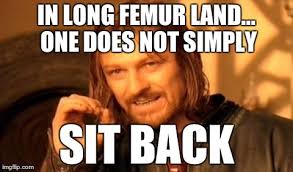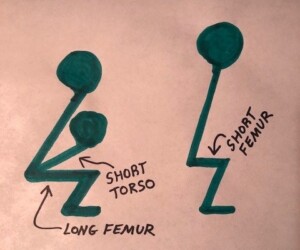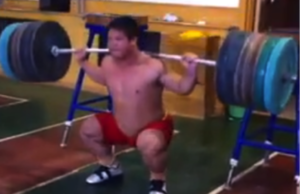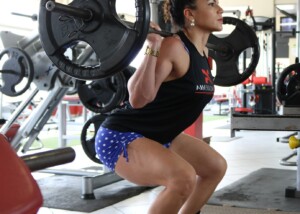
Yes, long femurs DO really SCREW up the back squat!
It’s interesting that the men in fitness forums who slam those who insist their long femurs screw up their back squats don’t suffer from long femurs themselves — though they may think they do.
Whenever someone posts that their long femurs cause problems with the back squat, someone invariably posts that HE, too, has the very long femurs (e.g., “I’m 6-3 but go ATG without a problem!”)
The “long femur” in the strength training and powerlifting community refers to length of thigh RELATIVE to torso. It can be one of two ways:
1) Femur is longer than torso—and torso may be medium relative to body, or short, relative to body, but the bottom line is the femur is longer than the torso. OR…
2) Torso is same length as femur, but the problem is that the shin is too short, relative to length of femur. So even though femur-torso relationship is okay, the short shin creates the problem.
It can also refer to the length of the femur relative to the length of the shin (from knee to ankle). A “short shin” will impact the squat.
We are not all built the same.

We can’t all be built the same for the back squat yet built differently when it’s time to be fitted for a suit, or when adjusting the car seat angle plus its proximity to the pedals plus its height.
Ironically, these same critics will agree:
#1. Long, “ape-like” arms (relative to the body height) are a big disadvantage in bench pressing.
#2. Short, “T-rex” arms (relative to the body height) are a big disadvantage in the deadlift.
#3. Long “spider” arms will kill anyone’s chance at excelling with Olympic-style weightlifting.
Oddly, these critics slam the long femur excuse for a lousy back squat.
The difference in bench press and back squat body proportions is this:
No matter how “disadvantaged” the ape armed person is compared to the T-rex armed person, the “gorilla” can STILL bench press with perfect form and efficiency (though they’re at greater risk for rotator cuff strain). It’s just that they probably won’t win competitions.
In the case of the long femurs to regular torso, or the regular femurs to short torso, or long femurs to short torso, and especially relatively short shins tossed into this equation — these proportions get in the way with the ability to efficiently perform the back squat.
Such proportions force the athlete into a very bent-forward position, unlike the genetic freak below:

One must fight to keep his or her back in decent position, battling to keep it from rounding.
There is also ongoing tension in the entire vertebral column due to this awkward positioning of having to lean so far forward yet maintain the lower back ARCH.
Can bad proportions be offset by increasing one’s ankle, hip and knee flexibility?
To a small degree, yes. But there are limits to how far you can drive your knees over the ankles (though Olympic-style weightlifters are trained for significant dorsiflexion).
If the knee is too far over the toes, this puts strain on the knee joint.
Hips can only sink so far, too. These fine-tuning adjustments make a difference, but there’s no substitute for being born with great proportions!
Even if you developed amazing flexibility in the ankle, this fails to solve the bad biomechanics of longer femur to torso proportion, because the significant angling forward of the knees (due to extreme ankle flexibility) is akin to doing the back squat with one’s heels on a little platform!
That’s a lot of tension on the knee’s patellar tendon!
Imagine performing back squats while you’re on the balls of your feet.
Forget the balance issue. Instead, imagine how your knees would feel, going up and down this way with heavy weight across the back.
If your femurs exceed the length of your torso, you have a legitimate concern, especially with ATG (“ass to grass”).
Try the following adjustments:
1) Widen the stance; work on hip flexibility
2) Slightly point feet outward
3) Wear a one-inch heel insert
If these adjustments fail, the back squat just isn’t your thing; focus on other leg exercises (split squats, dumbbell squats, box squats). On the flip side, long femurs are an advantage in kickboxing!
 Lorra Garrick is a former personal trainer certified through the American Council on Exercise. At Bally Total Fitness she trained women and men of all ages for fat loss, muscle building, fitness and improved health.
Lorra Garrick is a former personal trainer certified through the American Council on Exercise. At Bally Total Fitness she trained women and men of all ages for fat loss, muscle building, fitness and improved health.

























